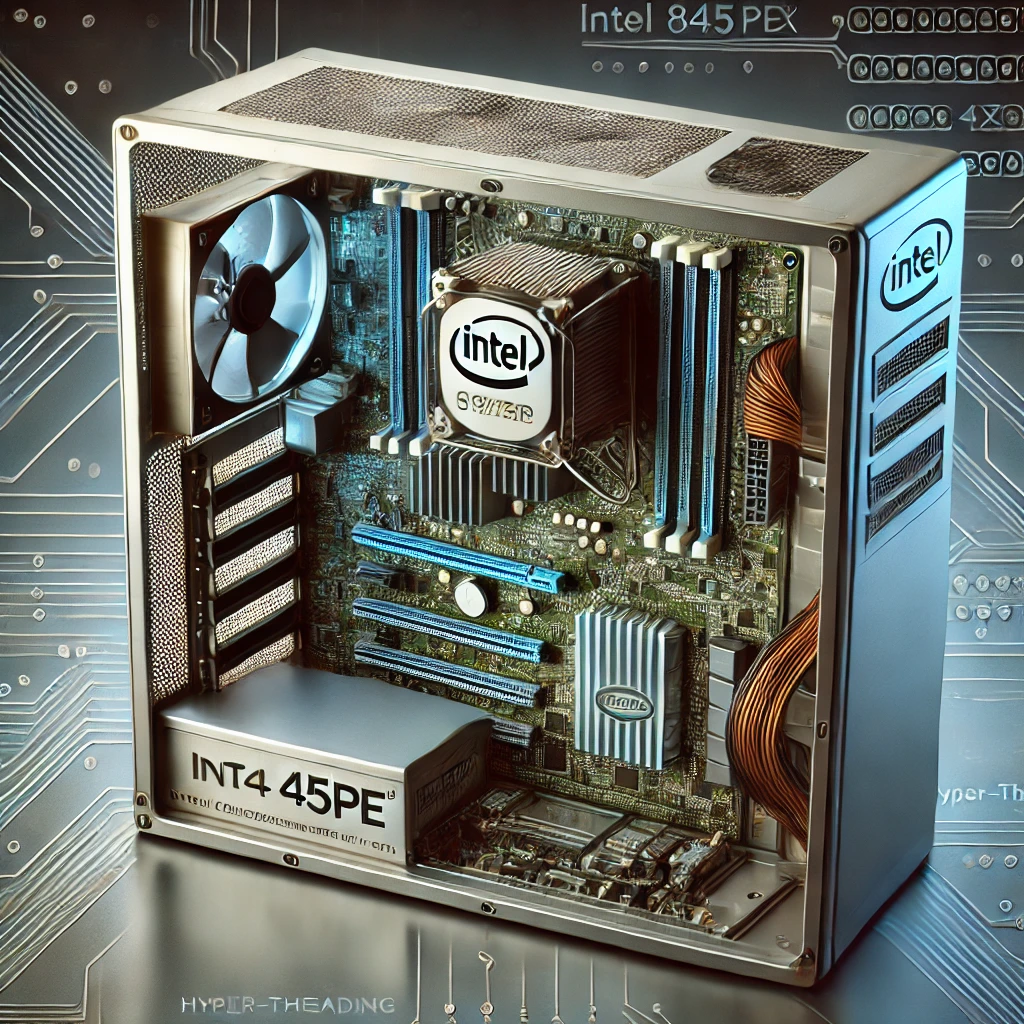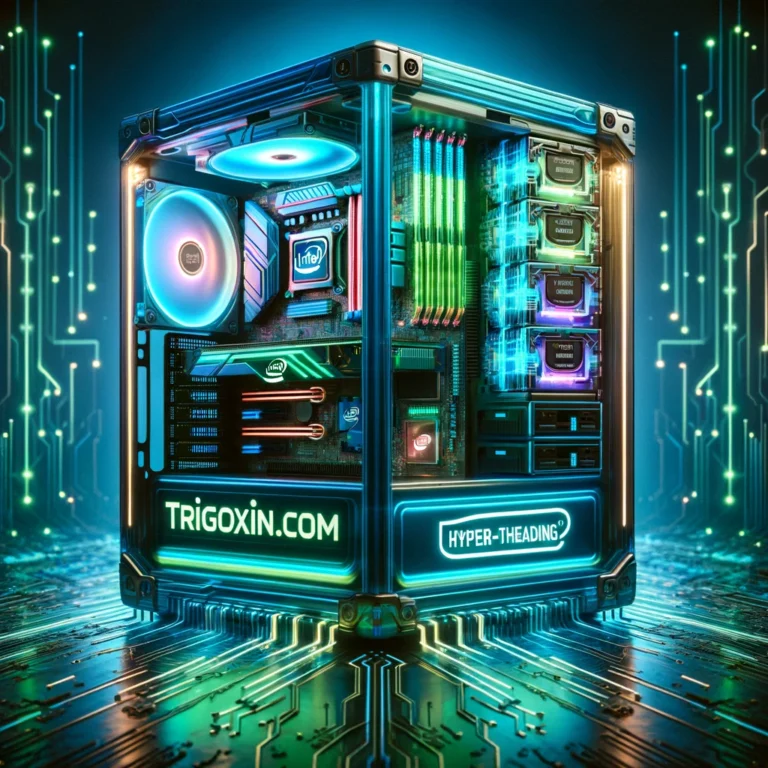Exploring Hyper-Threading Technology Intel 845PE: The Gateway to Efficient Computing
The evolution of computing technology is a story of constant innovation, where each breakthrough lays the foundation for the next. Among the transformative milestones in the history of processors is Hyper-Threading Technology Intel 845PE, a revolutionary development that redefined how computers handle multitasking and performance. In this detailed exploration, we’ll uncover what makes this technology special, how it works, its benefits, limitations, and its lasting legacy. Whether you’re a tech enthusiast or a historian of computing, this journey into Hyper-Threading Technology Intel 845PE will give you valuable insights.

Understanding Hyper-Threading Technology
Hyper-threading is Intel’s proprietary technology introduced to boost the performance of processors by enabling simultaneous execution of multiple threads on a single physical CPU core. It works by creating two logical cores per physical core, the processor to handle twice the number of tasks concurrently.
The introduction of Hyper-Threading Technology Intel 845PE was a major step forward in the early 2000s, setting a benchmark for performance in personal and professional computing. By simulating dual-core capabilities on a single-core processor, hyper-threading made multitasking more efficient, helping users accomplish more in less time.
The Intel 845PE Chipset: An Overview
The Intel 845PE chipset was part of the Pentium 4 ecosystem and became a critical player in early 2000s computing. It was designed to support DDR333 (PC2700) memory, AGP 4X graphics, and included support for a 533 MHz front-side bus, making it a versatile choice for desktops. Its compatibility with Hyper-Threading Technology Intel 845PE elevated its status among tech enthusiasts and professionals seeking reliable performance.
While the Intel 845PE chipset may seem modest by today’s standards, at the time, it was a cost-effective solution that balanced performance and affordability. It offered a glimpse into the potential of hyper-threading, showcasing how one innovation could transform user experiences across diverse applications.
How Hyper-Threading Technology Intel 845PE Works
To truly appreciate Hyper-Threading Technology Intel 845PE, it’s essential to understand how it functioned within the chipset. Here’s a closer look:
- Virtual Cores: Hyper-threading enabled the processor to divide its physical core into two logical cores. Each logical core acted like an independent processor, capable of running its own thread.
- Simultaneous Multithreading: With two threads running simultaneously on one core, the processor could handle multiple tasks more effectively than single-threaded processors.
- Intelligent Task Allocation: The processor dynamically distributed workloads across the two threads, ensuring that the execution units were utilized efficiently.
- Increased Throughput: By reducing idle times and enhancing resource utilization, hyper-threading significantly improved performance for multithreaded applications.
For example, when using Hyper-Threading Technology Intel 845PE, a user editing videos while encoding another file in the background would experience smoother and faster processing compared to non-hyper-threaded systems.

Advantages of Hyper-Threading Technology Intel 845PE
The implementation of hyper-threading in the Intel 845PE chipset brought numerous benefits to the forefront. Here are some of the standout advantages:
1. Enhanced Multitasking
One of the most significant benefits of Hyper-Threading Technology Intel 845PE was its ability to handle multiple tasks simultaneously without noticeable slowdowns. Users could browse the internet, stream videos, and run system scans concurrently without sacrificing performance.
2. Faster Processing of Multithreaded Applications
Applications optimized for multithreading, such as video editing software, 3D rendering tools, and certain games, experienced significant performance improvements. Tasks that previously required substantial time were completed faster with hyper-threading.
3. Efficient Resource Utilization
The ability to run two threads per core ensured that the processor’s execution units were almost always active, minimizing idle time and maximizing productivity.
4. Improved Gaming Experiences
While not all games of the era were optimized for hyper-threading, those that were enjoyed smoother gameplay and faster loading times.
5. Cost-Effective Performance Boost
Unlike adding more physical cores, which was expensive, hyper-threading offered a performance boost through software and hardware optimization, making it an affordable solution for users of the Intel 845PE chipset.
Limitations of Hyper-Threading Technology Intel 845PE
Despite its groundbreaking features, Hyper-Threading Technology Intel 845PE was not without its limitations. Understanding these drawbacks provides a balanced perspective on the technology:
1. Software Dependency
Hyper-threading’s benefits were only fully realized when software was designed to support multithreading. Applications that lacked optimization for multiple threads did not show significant performance gains.
2. Thermal Challenges
Running two threads per core generated more heat, necessitating efficient cooling solutions. In systems with inadequate cooling, this could lead to thermal throttling.
3. Limited Impact on Single-Threaded Tasks
While hyper-threading enhanced multitasking, single-threaded applications did not see the same level of improvement, as they relied solely on a single core’s capabilities.
4. Power Consumption
Although relatively efficient, hyper-threading consumed more power compared to a single-threaded architecture, which was a consideration for energy-conscious users.
Use Cases of Hyper-Threading Technology Intel 845PE
The practical applications of Hyper-Threading Technology Intel 845PE were varied, making it a valuable asset across different scenarios:
- Video Editing and Rendering: Creative professionals benefited from faster rendering times and smoother workflows.
- Office Productivity: Multitasking became seamless, enabling users to work on multiple documents while running background processes.
- Gaming: Early gaming enthusiasts experienced enhanced performance in titles optimized for multithreading.
- Scientific Applications: Researchers and engineers used systems with Intel 845PE chipsets to run simulations and data analysis more efficiently.
Legacy and Impact of Hyper-Threading Technology Intel 845PE
Although the Intel 845PE chipset is no longer in active use, its introduction of hyper-threading technology had a profound impact on the tech industry. It marked the beginning of a new era in processor design, where multitasking and resource efficiency became paramount. The principles of Hyper-Threading Technology Intel 845PE are still at the core of Intel’s modern processors, including the Core i3, i5, i7, and Xeon series.
Today, hyper-threading is a standard feature in many CPUs, helping users achieve unparalleled performance in everything from everyday tasks to complex computations. The Intel 845PE chipset stands as a historical landmark, reminding us of the ingenuity that drives technological progress.
Conclusion
Hyper-Threading Technology Intel 845PE was a groundbreaking innovation that reshaped computing in the early 2000s. By enabling processors to handle multiple threads simultaneously, it unlocked new levels of efficiency and performance, setting the stage for future advancements in processor technology.
From enhanced multitasking to faster execution of demanding applications, Hyper-Threading Technology Intel 845PE proved to be a game-changer. Its influence continues to be felt in modern computing, making it a pivotal chapter in the history of technology. As we look back at this innovation, we can appreciate the enduring legacy of Intel’s commitment to pushing the boundaries of what processors can achieve.
FAQs About Hyper-Threading Technology Intel 845PE
1. What is Hyper-Threading Technology?
Hyper-threading is Intel’s proprietary technology that allows a single physical processor core to function as two logical cores, enabling it to handle multiple tasks (threads) simultaneously. It boosts multitasking and improves performance in applications optimized for multithreading.
2. What is the Intel 845PE chipset, and why is it significant?
The Intel 845PE chipset was a part of the Pentium 4 ecosystem, designed to support DDR333 memory, AGP 4X graphics, and a 533 MHz front-side bus. When paired with Hyper-Threading Technology Intel 845PE, it provided an affordable, high-performance platform for multitasking and demanding applications in the early 2000s.
3. How does Hyper-Threading Technology Intel 845PE improve multitasking?
By creating two logical cores from a single physical core, hyper-threading allows the processor to run two threads simultaneously. This reduces idle time, enhances resource utilization, and ensures smoother performance when running multiple programs at once.
4. Which types of applications benefit most from Hyper-Threading Technology Intel 845PE?
Applications optimized for multithreading, such as video editing software, 3D rendering tools, and some gaming titles, experience the most significant performance gains. Tasks like video encoding, file compression, and running virtual machines also see improvements.
5. Does Hyper-Threading Technology Intel 845PE help with gaming?
Yes, but the extent of the improvement depends on the game. Early 2000s games optimized for multithreading performed better with hyper-threading, offering smoother gameplay and reduced loading times. However, single-threaded games saw limited benefits.
6. What are the limitations of Hyper-Threading Technology Intel 845PE?
- Software Dependency: The benefits depend on whether applications are optimized for multithreading.
- Increased Heat Output: Running two threads per core generates more heat, requiring effective cooling solutions.
- Single-Threaded Applications: These see minimal performance improvement since they utilize only one thread.
- Power Consumption: Hyper-threading can slightly increase power usage compared to single-threaded processing.
7. Was the Intel 845PE chipset widely used?
Yes, the Intel 845PE chipset was popular among both home and professional users during its time due to its cost-effective performance. It balanced affordability and multitasking capabilities, making it a preferred choice for users seeking reliable computing.
8. How did Hyper-Threading Technology Intel 845PE influence modern processors?
It laid the groundwork for the multitasking capabilities of today’s processors. Modern CPUs like Intel Core i3, i5, i7, and Xeon series still utilize hyper-threading, showcasing its enduring impact on computing efficiency.
9. Can I still use systems with Intel 845PE and hyper-threading today?
While systems with the Intel 845PE chipset are outdated by modern standards, they can still handle basic tasks like document editing and web browsing. However, they lack the power and compatibility required for current software and operating systems.
10. Why was Hyper-Threading Technology Intel 845PE a game-changer in its time?
It introduced efficient multitasking to personal computing at an affordable price. By allowing a single-core processor to handle multiple threads, it revolutionized how users approached complex tasks like video editing, gaming, and productivity.
11. Is hyper-threading the same as having multiple physical cores?
No. Hyper-threading creates two logical cores on a single physical core, simulating dual-core functionality. Multiple physical cores provide better performance but are more expensive to manufacture and use more power. Hyper-threading was a cost-effective alternative.
12. How did Hyper-Threading Technology Intel 845PE compare to competitors at the time?
The combination of the Intel 845PE chipset and hyper-threading technology offered better multitasking and application performance than many competing solutions, making it a leader in affordable high-performance computing.
13. What cooling solutions were recommended for systems using Hyper-Threading Technology Intel 845PE?
Efficient air or liquid cooling systems were recommended to manage the additional heat generated by hyper-threading. Proper airflow within the system and quality thermal paste were also essential.
14. Does hyper-threading affect power efficiency?
Yes, hyper-threading slightly increases power consumption due to the simultaneous execution of multiple threads. However, the performance gains often outweigh the additional power usage.
15. Can I enable or disable hyper-threading on Intel 845PE systems?
Yes, hyper-threading can typically be enabled or disabled through the system’s BIOS settings. Users could toggle it based on their performance needs or compatibility with specific software.
16. How did Hyper-Threading Technology Intel 845PE improve user experiences in the early 2000s?
It allowed users to run multiple demanding applications simultaneously without significant slowdowns. This was particularly beneficial for professionals in video editing, graphic design, and engineering fields.
17. Are there any modern equivalents to Hyper-Threading Technology Intel 845PE?
Modern Intel processors, such as those in the Core and Xeon series, feature advanced hyper-threading implementations. These offer even greater efficiency and are optimized for today’s multithreaded software.
18. Why was the Intel 845PE chipset paired with hyper-threading technology?
The Intel 845PE chipset offered strong memory and graphics support, making it an ideal platform for showcasing hyper-threading. Its compatibility with DDR333 and AGP 4X graphics ensured balanced performance for a wide range of tasks.
19. Was Hyper-Threading Technology Intel 845PE suitable for professional workloads?
Yes, the combination of the Intel 845PE chipset and hyper-threading technology was suitable for entry-level professional workloads, such as video editing, CAD, and other compute-intensive tasks.
20. What is the legacy of Hyper-Threading Technology Intel 845PE?
The legacy of Hyper-Threading Technology Intel 845PE lies in its role as a precursor to the advanced processors we use today. It demonstrated how multitasking and resource efficiency could elevate computing performance, influencing the design of modern CPUs.

